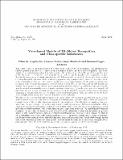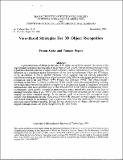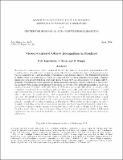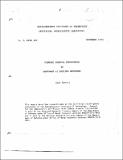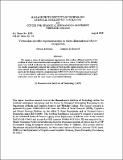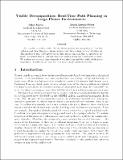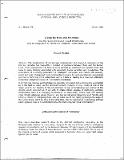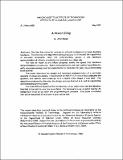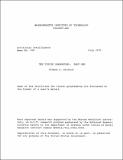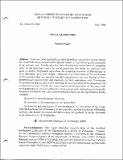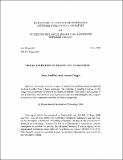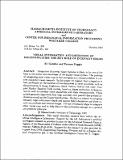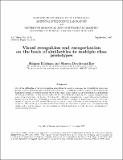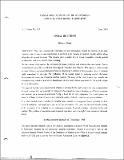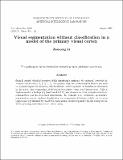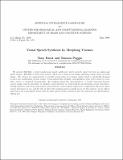Browsing AI Memos (1959 - 2004) by Title
Now showing items 1181-1200 of 1217
-
View-Based Models of 3D Object Recognition and Class-Specific Invariances
(1994-04-01)This paper describes the main features of a view-based model of object recognition. The model tries to capture general properties to be expected in a biological architecture for object recognition. The basic module is a ... -
View-Based Strategies for 3D Object Recognition
(1995-04-21)A persistent issue of debate in the area of 3D object recognition concerns the nature of the experientially acquired object models in the primate visual system. One prominent proposal in this regard has expounded the ... -
Viewer-Centered Object Recognition in Monkeys
(1994-04-01)How does the brain recognize three-dimensional objects? We trained monkeys to recognize computer rendered objects presented from an arbitrarily chosen training view, and subsequently tested their ability to generalize ... -
Viewing Control Structures as Patterns of Passing Messages
(1976-12-01)The purpose of this paper is to discuss some organizational aspects of programs using the actor model of computation. In this paper we present an approach to modelling intelligence in terms of a society of communicating ... -
Viewpoint-Specific Representations in Three-Dimensional Object Recognition
(1990-08-01)We report a series of psychophysical experiments that explore different aspects of the problem of object representation and recognition in human vision. Contrary to the paradigmatic view which holds that the representations ... -
Virtual Visual Hulls: Example-Based 3D Shape Estimation from a Single Silhouette
(2004-01-28)Recovering a volumetric model of a person, car, or other object of interest from a single snapshot would be useful for many computer graphics applications. 3D model estimation in general is hard, and currently requires ... -
Visible Decomposition: Real-Time Path Planning in Large Planar Environments
(1998-06-01)We describe a method called Visible Decomposition for computing collision-free paths in real time through a planar environment with a large number of obstacles. This method divides space into local visibility graphs, ... -
Vision by Man and Machine
(1984-03-01)The development of increasingly sophisticated and powerful computers in the last few decades has frequently stimulated comparisons between them and the human brain. Such comparisons will become more earnest as computers ... -
A Vision Chip
(1981-05-01)Some well understood and well justified algorithms for early visual processing must be implemented in hardware for later visual processing to be studied. This paper describes the design and hardware implementation of ... -
The Vision Laboratory: Part One
(1970-07-01)Some of the facilities for vision programming are discussed in the format of a user's manual. -
Vision Memo
(1967-02-01)This Memo proposes a set of systems programs for vision work. Please comment immediately as we should start on it at once. Values stored outside an array range should have no effect, but set an overflow flag: values read ... -
Visual Algorithms
(1982-05-01)Nonlinear, local and highly parallel algorithms can perform several simple but important visual computations. Specific classes of algorithms can be considered in an abstract way. I study here the class of polynomial ... -
Visual Attention in Brains and Computers
(1986-09-01)Existing computer programs designed to perform visual recognition of objects suffer from a basic weakness: the inability to spotlight regions in the image that potentially correspond to objects of interest. The brain's ... -
Visual Integration and Detection of Discontinuities: The Key Role of Intensity Edges
(1987-10-01)Integration of several vision modules is likely to be one of the keys to the power and robustness of the human visual system. The problem of integrating early vision cues is also emerging as a central problem in current ... -
Visual Position Extraction using Stereo Eye Systems with a Relative Rotational Motion Capability
(1973-03-01)This paper discusses the problem of context-free position estimation using a stereo vision system with moveable eyes. Exact and approximate equations are developed linking position to measureable quantities of the ... -
Visual Recognition and Categorization on the Basis of Similarities to Multiple Class Prototypes
(1997-09-01)To recognize a previously seen object, the visual system must overcome the variability in the object's appearance caused by factors such as illumination and pose. Developments in computer vision suggest that it may be ... -
Visual Routines
(1983-06-01)This paper examines the processing of visual information beyond the creation of the early representations. A fundamental requirement at this level is the capacity to establish visually abstract shape properties and ... -
Visual Segmentation without Classification in a Model of the Primary Visual Cortex
(1997-08-01)Stimuli outside classical receptive fields significantly influence the neurons' activities in primary visual cortex. We propose that such contextual influences are used to segment regions by detecting the breakdown of ... -
Visual Speech Synthesis by Morphing Visemes
(1999-05-01)We present MikeTalk, a text-to-audiovisual speech synthesizer which converts input text into an audiovisual speech stream. MikeTalk is built using visemes, which are a small set of images spanning a large range of mouth ... -
Visual Tracking
(1992-10-01)A typical robot vision scenario might involve a vehicle moving with an unknown 3D motion (translation and rotation) while taking intensity images of an arbitrary environment. This paper describes the theory and implementation ...

